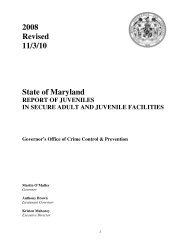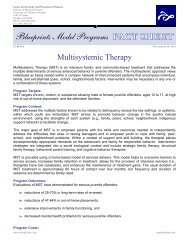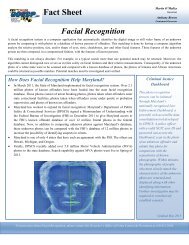Targeted Outreach - Governor's Office of Crime Control & Prevention ...
Targeted Outreach - Governor's Office of Crime Control & Prevention ...
Targeted Outreach - Governor's Office of Crime Control & Prevention ...
Create successful ePaper yourself
Turn your PDF publications into a flip-book with our unique Google optimized e-Paper software.
20 <strong>Targeted</strong> <strong>Outreach</strong><br />
Table 10<br />
Target Youth’s Club Attendance One Year After Joining*<br />
Percentage <strong>of</strong> target youth who have: <strong>Prevention</strong> Youth Intervention Youth<br />
Gone to the Club/Project in the past 4 weeks:<br />
not at all 27% 32%<br />
1-2 times 12% 27%<br />
about once a week 11% 12%<br />
2-3 times a week 11% 9%<br />
almost everyday 39% 12%<br />
Never gone to the Club/Project 3% 23%<br />
* Data is based on the baseline surveys <strong>of</strong> 236 prevention youth and 66 intervention youth who also<br />
completed follow-up interviews.<br />
surveyed were attending the Club/Project frequently<br />
one year after intake. Specifically, half <strong>of</strong> all prevention<br />
youth and a quarter <strong>of</strong> all intervention youth<br />
reported that they were attending the Club/Project<br />
several times a week at follow-up.<br />
Youth also seemed to be spending a significant<br />
amount <strong>of</strong> time at the Club during their visits.<br />
Ninety-two percent <strong>of</strong> prevention and 75 percent <strong>of</strong><br />
intervention youth reported spending more than<br />
one hour at the Club, on average, during their visits<br />
in the month prior to the follow-up survey. More<br />
than half <strong>of</strong> prevention (51%) and 15 percent <strong>of</strong><br />
intervention youth stayed at the Club, on average,<br />
for more than three hours per visit.<br />
As we saw in the last chapter, many <strong>of</strong> the youth<br />
recruited through GPTTO and GITTO are youth<br />
who are already involved or at high risk <strong>of</strong> involvement<br />
in the gang lifestyle—a way <strong>of</strong> life that puts its<br />
members at risk <strong>of</strong> committing crimes and violent<br />
acts, and puts their own lives at risk. A year after<br />
being introduced to the Club or program, half or<br />
more <strong>of</strong> these high-risk youth were still attending.<br />
At a minimum, having high-risk youth involved in<br />
the Club for an extended period <strong>of</strong> time is a positive<br />
outcome. If youth are at the Club, they are<br />
involved in healthy activities and are not on the<br />
street, unsupervised.<br />
What Did the Youth Experience?<br />
Through their participation, target youth received<br />
important developmental supports that they may not<br />
have in other facets <strong>of</strong> their lives. Specifically, youth<br />
were provided with the support and guidance <strong>of</strong> caring<br />
adults and a sense <strong>of</strong> belonging, as well as challenging<br />
and interesting activities to hold their<br />
attention. These supports fit the description <strong>of</strong> what<br />
many youth seek through involvement with gangs. At<br />
the same time, research has shown that these supports<br />
contribute to a more positive life trajectory.<br />
Adult Support and Guidance<br />
Adult support is a critical component <strong>of</strong> successful<br />
development for youth. Young people need a sounding<br />
board for their thoughts and questions about<br />
family, peers and school. They need adult guidance<br />
when making decisions—how to get a job, how to<br />
handle conflict with adults and peers, what classes to<br />
take or what college to attend. Indeed, one <strong>of</strong> the<br />
most consistent findings in the research is the way<br />
that a positive adult role model can contribute to<br />
youth’s successful transitions (e.g., Tierney and<br />
Grossman, 1995; Werner and Smith, 1982).<br />
Because some youth look to gangs as surrogate families,<br />
the <strong>Targeted</strong> <strong>Outreach</strong> approach needs to surround<br />
youth with adult attention. Adults at the Club<br />
can also serve a more instrumental purpose by helping<br />
guide youth in decision-making and “getting on<br />
their case” if they are going <strong>of</strong>f track.<br />
Youth did feel supported by the adults at the<br />
Club/Project. Almost all youth (96 percent <strong>of</strong> prevention<br />
and 86 percent <strong>of</strong> intervention) reported<br />
receiving adult support and guidance from at least<br />
one Boys & Girls Club staff member on average.<br />
More than half reported that they received support<br />
from two or more staff people (79 percent <strong>of</strong> prevention<br />
and 53 percent <strong>of</strong> intervention). In another

















